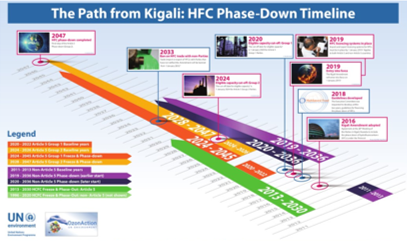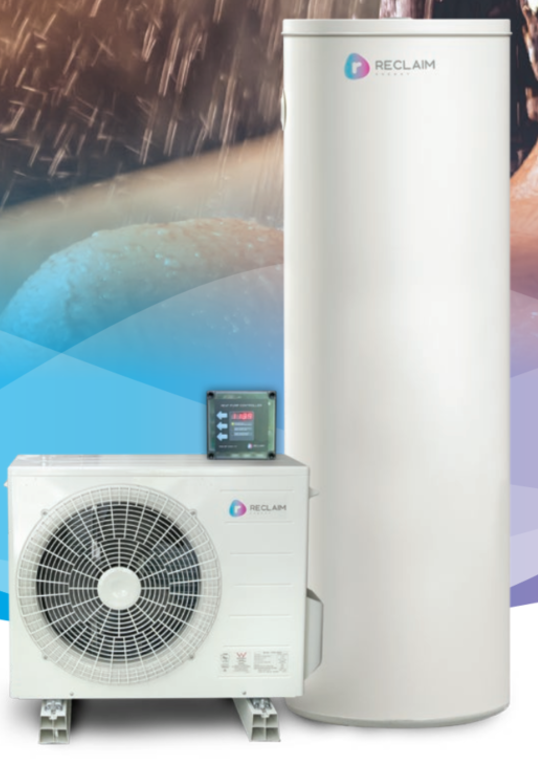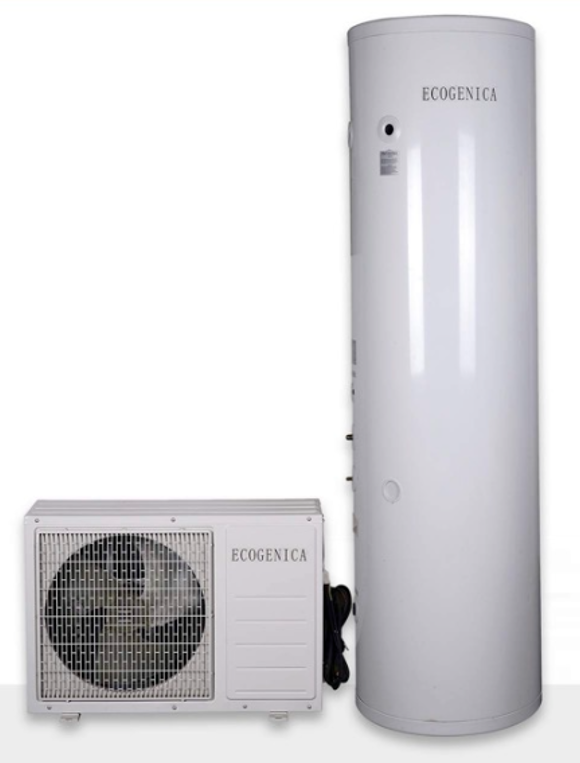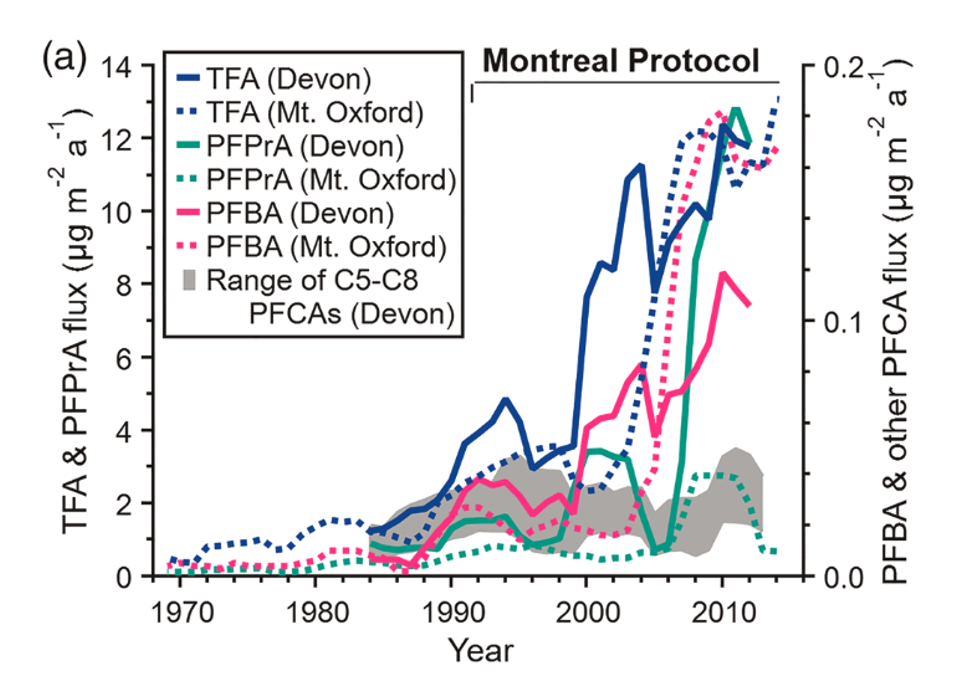
Introduction
Heat pump refrigerants have steadily evolved since the 1987, when the Montreal Protocol set the objective of phasing out harmful refrigerants for the environment.
The later Kilgari amendment put in place a time line to phase down the use of man-made hydrofluorocarbon (HFC) refrigerants which have very high global warming potential (GWP).
This BLOG discusses the emergence of natural and improved man-made refrigerants with low GWP for heat pump hot water, space heating and air conditioning systems.
Reference: Montreal protocol
Natural Refrigerants
Several natural refrigerants have emerged for heat pump and air conditioning systems with excellent thermodynamic properties and low Global Warming Potential (GWP) that also satisfy the Montreal Protocol objective. These are:
- Carbon dioxide (R744, GWP 1)
- Propane (R290, GWP 3)
- Isobutane (R600A, GWP 3)
- Propylene (R1270, GWP 2)
Ozone Safe, Negligible GWP
- Carbon dioxide and propane are now being used in heat pump water heaters. Propane is also being used in hydronic heat pumps. These are safe for our ozone layer and have negligible GWP.
- Both have much better GWP than man-made refrigerants still widely used in heat pumps and air conditioners today.
- For example, man-made HFC refrigerants such as R134A and R410A have GWPs of 1430 and 2088 respectively.
Carbon Dioxide Refrigerant
The natural refrigerant carbon dioxide (R744) can heat water to 90 degrees and is non-flammable. It is the refrigerant against which others are compared for GWP, which is 1.
However, carbon dioxide requires higher operating pressures and a more complex refrigerant system. Therefore, equipment must be more robust and sophisticated, which is more expensive.
Heat pump water heaters charged with carbon dioxide are very effective in cold weather, even sub zero. For Alpine and other cold winter climates, carbon dioxide is the best choice.
However, carbon dioxide is not yet suitable for hydronic heat pumps and air conditioners because it needs a very wide difference between the flow and return temperatures, at least 30 degrees. As space heating and cooling set points are reached, this difference becomes too narrow for carbon dioxide refrigerant.


Propane Refrigerant
The natural refrigerant propane (R290) is a hydrocarbon that can heat water to 75 degrees. It has a GWP of 3. Operating pressures are lower than carbon dioxide and the refrigerant system is simpler. This makes equipment less expensive.
However, propane is flammable so this risk needs to be managed appropriately. Make sure the heat pump is installed outside and away from combustible material. This is also important for operational efficiency if it is an air-sourced heat pump, most common in Australia.
In a domestic heat pump water heater, the amount of propane used can be as little as 500 grams, which is 17 times less than a common BBQ gas bottle of 9kg. During installation, a refrigerant leak-test should be done to ensure tight pipe connections and no leaks.
A great attraction of propane is that it can be used for hydronic heat pumps and air conditioners because it does not need a wide difference between the flow and return temperatures.
Other Hydrocarbon Refrigerants
Isobutane (R600A) and Propylene (R1270) are other natural hydrocarbon refrigerants gaining popularity even though they are flammable.
Isobutane (GWP 3) is favoured for domestic and light-commercial refrigerators and freezers.
Propylene (GWP 2) is favoured for medium and low temperature systems such as chillers.
Ammonia Refrigerant
Ammonia (R717) also has excellent thermodynamic properties with a GWP of 0. However, it is toxic, mildly flammable and abrasive for materials such as copper and brass.
Therefore, it is unlikely to be used for heat pump and air conditioning systems any time soon.
Man-made Refrigerants
Man-made refrigerants have come a long way since the early days of Freon R12 with GWP of 10,200 and damaging to the ozone layer.
Hydrochlorofluorocarbon (HCFC) refrigerants such as R22 came next with much lower GWP of 1,810. However, HCFC refrigerants also cause damage to the ozone layer.
Hydrofluorocarbon (HFC)
Hydrofluorocarbon (HFC) refrigerants such as R134A and R410A came next, introduced since 1990. They do not harm the ozone layer directly but still have high GWP. In 2012, Daikin launched an improved HFC refrigerant R32 with GWP of 675, a significant improvement. It has excellent thermodynamic properties but is mildly flammable.
Whilst the GWP of R32 is much better than other HFC refrigerants, it is still well above the GWP of natural refrigerants.
Hydrofluoroolefin (HFO)
Hydrofluoroolefin (HFO) refrigerants came next in 2013. The HFO refrigerant R1234YF is now being widely used in automotive air conditioning. The attraction is its very low GWP of 4 compared to 1430 for the HFC refrigerant R134A that it replaces. However, it is mildly flammable and new studies have found that atmospheric degradation of this refrigerant over time creates trifluoroacetic acid (TFA).
This acid is highly soluble in water and therefore causes acid rain. Canadian research in the Arctic region has found that widespread adoption of heat pump and air conditioning systems with HFO refrigerants will lead to an increase in TFA acid rain.
Reference: Geophysical Research Letters Volume 47, Issue 10 May 2020

Other refrigerants
Other refrigerants being considered for heat pump and air conditioning systems include:
- R454C (GWP 148), a blend of R1234YF and R32
- R450A (GWP 605), a blend of R1234YF and R134A
- R513A (GWP 631), a blend of R1234YF and R134A
New Rules
New rules for charging refrigeration and air conditioning equipment came into force in Australia on 1 January 2020 to support the HFC phase down. Now, you cannot recharge heat pump, air conditioning and refrigeration equipment with a refrigerant of higher GWP than that of the original design.
Reference: Federal Dept. of Climate Change, Energy, the Environment and Water
Conclusion
All heat pump and air conditioning refrigerants have their pros and cons. Due to urgent action needed now to avoid catastrophic climate change, natural and man-made refrigerants with low GWP are becoming essential.
Natural refrigerants are gaining widespread support because of their environmental and performance benefits.
Carbon dioxide is an inflammable refrigerant with negligible GWP, but its physical properties and higher costs limit its use. It is best suited for heat pump water heaters in cold or alpine climates.
Heat pumps using propane also have negligible GWP and are less expensive but their flammability needs to be managed by installing them outside, checking for leaks and locating them away from flammable materials. Propane is best suited for heat pump water heaters and hydronic heat pumps in temperate coastal locations.
